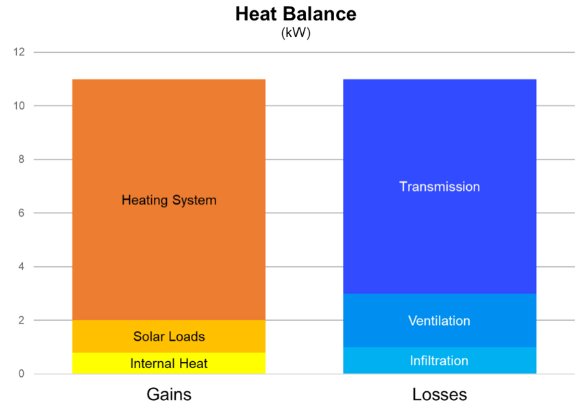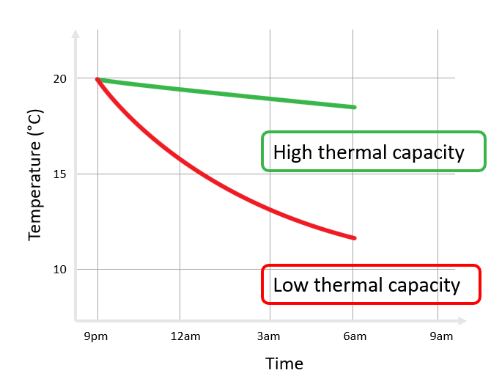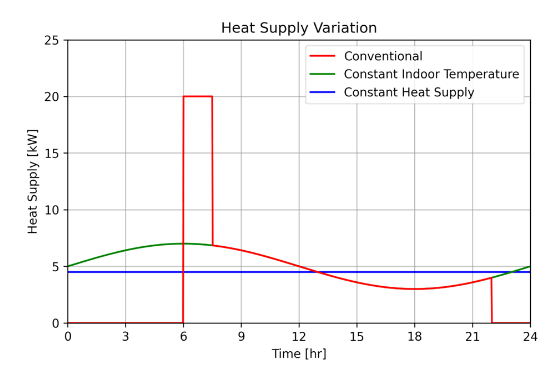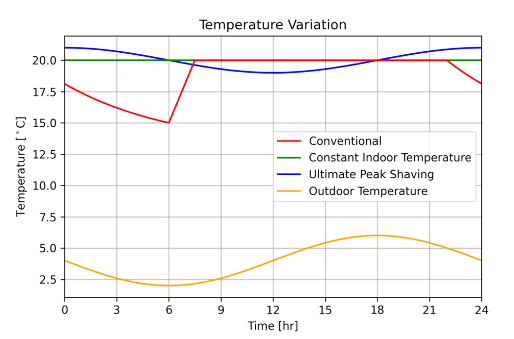4.2.2 Lecture Notes Thermal Demand
Course subject(s)
4. Intelligent Control and Integration of Heating in the Energy Systems

This image is from freepik
This lecture will introduce the heating demand of buildings. The following topics will be covered:
- The heating demand of a building
- The thermal time constant
- Different heating control strategies
The heating demand of a building
First, the heat balance of a building in steady state is taken as an example. In this example, it is cold outside, and the building is heated, such that there is a comfortable temperature inside. Due to the heating, there is an energy difference between the outside and the inside, which causes heat losses. These heat losses consist of different components:
- Transmission losses, which are dependent on the temperature difference between outside and inside, and the thermal properties of the building.
- Ventilation losses, which occur because cold air is going into the house, and warm air going out of the house, due to ventilation.
- Infiltration losses, which occur when there is unwanted leakage of air.
Besides the heat losses, there are also heat gains. The heat gains consist of the following components:
- Solar loads, which occur because the sun is shining on the house. This depends on the climate/weather, orientation, window size, and sun shading properties of the building.
- Internal heat, which is heat coming from electrical equipment in the house, such as lamps or computers.
- Heating system, which is heat coming from radiators in the house.
If the heat gains are the same as the heating losses, then the building will stay in thermal equilibrium and there is a heat balance. An example of a heat balance is shown in the figure below. The heat required by the heating system is the difference between the heating losses and the sum of the solar loads and the internal heat. This required heat is known as the heating demand.

The figure above shows the heating demand of a specific moment in time. Since the heating demand can vary for different hours of the day, a heating strategy is needed. In a conventional heating strategy, the heating is turned on during the day to provide a comfortable temperature, and it is turned off during the night. This causes the temperature to decrease gradually during the night. In the morning, the heating is turned on to increase the temperature, and this requires a large amount of heating power. Therefore, there is a high peak of heating demand in the morning.
The thermal time constant
How quickly the temperature decreases during the night depends on the thermal properties. In the figure below, the temperature curves of two different buildings are plotted. The temperature of the building with a high thermal capacity will decrease slowly, and the temperature of the building with a low thermal capacity will decrease fast.

The time it takes for the temperature to decrease depends on the thermal time constant. The thermal time constant is the time it takes before the temperature difference has reduced with 63.2% and it is the ratio between the specific heating loss (H) and the thermal capacity (C). The thermal time constant (τ) can be calculated as follows:

If the time constant is lower, it means that the temperature will go down faster. The typical time constant for a house in the Netherlands is around 10 to 200 hours.
More information about the thermal time constant can be found on this link.
Different heating control strategies
There are different strategies for controlling the heating of a building. In this lecture, three different heating strategies are compared:
- Conventional heating strategy, which is the strategy that is discussed before.
- Maintain constant indoor temperature, where the temperature inside the building is kept constant.
- Maintain constant heat supply, where a constant heating power is supplied to the building.
To compare the different strategies, a simulation is done to see what the different heating supplies are. The different heating supplies are shown in the figure below. For the conventional heating strategy, there is a supply peak in the morning, as shown by the red line. For the constant indoor temperature strategy, there are small variations throughout the day. For constant heat supply, the power supply is constant for the whole day, which is also known as “ultimate peak shaving”.

The different heating strategies all have a different indoor temperature. For each strategy the temperature variation throughout the day is simulated, which is shown in the figure below, together with the outdoor temperature. In conventional heating, the temperature drops during the night and increases in the morning. For the constant indoor temperature, the temperature remains constant. With the constant heat supply strategy, the temperature will vary during the day.

The control strategy also influences the heat losses. As explained before, the heating losses depend on the temperature difference between the house and outside. For conventional heating, this difference is the lowest during the night. Therefore, the heat losses for this strategy are the lowest during the night. On average the conventional strategy has the lowest heat losses and therefore has the lowest thermal demand.
Conclusion
This lecture covered the thermal heating demand of a building. First, the different components of heating losses and heating gains in a thermal balance were discussed. After this, the thermal time constant, which indicates how fast the temperature will decrease during the night. Finally, three different heating strategies were compared and analysed.

Technology of Intelligent and Integrated Energy Systems by TU Delft OpenCourseWare is licensed under a Creative Commons Attribution-NonCommercial-ShareAlike 4.0 International License.
Based on a work at https://online-learning.tudelft.nl/courses/technology-of-intelligent-and-integrated-energy-systems/



